英语介词的正确使用方法
介词短语的用法
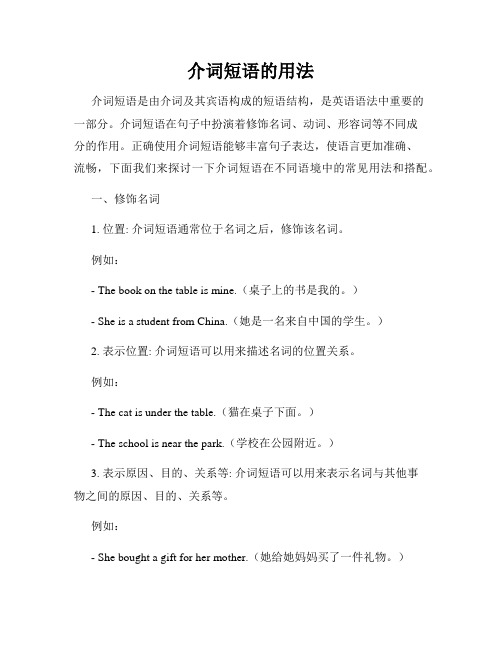
介词短语的用法介词短语是由介词及其宾语构成的短语结构,是英语语法中重要的一部分。
介词短语在句子中扮演着修饰名词、动词、形容词等不同成分的作用。
正确使用介词短语能够丰富句子表达,使语言更加准确、流畅,下面我们来探讨一下介词短语在不同语境中的常见用法和搭配。
一、修饰名词1. 位置: 介词短语通常位于名词之后,修饰该名词。
例如:- The book on the table is mine.(桌子上的书是我的。
)- She is a student from China.(她是一名来自中国的学生。
)2. 表示位置: 介词短语可以用来描述名词的位置关系。
例如:- The cat is under the table.(猫在桌子下面。
)- The school is near the park.(学校在公园附近。
)3. 表示原因、目的、关系等: 介词短语可以用来表示名词与其他事物之间的原因、目的、关系等。
例如:- She bought a gift for her mother.(她给她妈妈买了一件礼物。
)- We went to the cinema with our friends.(我们和朋友们一起去了电影院。
)二、修饰动词1. 位置: 介词短语通常位于动词之后,修饰该动词。
例如:- She looks after her younger brother.(她照顾她的弟弟。
)- They are talking about their vacation plans.(他们正在讨论他们的假期计划。
)2. 表示方式、原因、时间等: 介词短语可以用来表示动作发生的方式、原因、时间等。
例如:- He jumped into the water with joy.(他高兴地跳进水中。
)- They succeeded through hard work.(他们通过努力获得了成功。
)三、修饰形容词或副词1. 位置: 介词短语通常位于形容词或副词之后,修饰该形容词或副词。
怎样正确使用介词
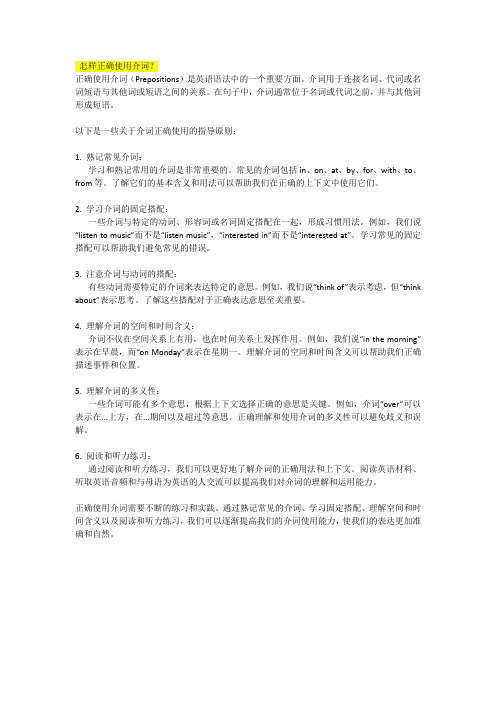
怎样正确使用介词?正确使用介词(Prepositions)是英语语法中的一个重要方面。
介词用于连接名词、代词或名词短语与其他词或短语之间的关系。
在句子中,介词通常位于名词或代词之前,并与其他词形成短语。
以下是一些关于介词正确使用的指导原则:1. 熟记常见介词:学习和熟记常用的介词是非常重要的。
常见的介词包括in、on、at、by、for、with、to、from等。
了解它们的基本含义和用法可以帮助我们在正确的上下文中使用它们。
2. 学习介词的固定搭配:一些介词与特定的动词、形容词或名词固定搭配在一起,形成习惯用法。
例如,我们说“listen to music”而不是“listen music”,“interested in”而不是“interested at”。
学习常见的固定搭配可以帮助我们避免常见的错误。
3. 注意介词与动词的搭配:有些动词需要特定的介词来表达特定的意思。
例如,我们说“think of”表示考虑,但“think about”表示思考。
了解这些搭配对于正确表达意思至关重要。
4. 理解介词的空间和时间含义:介词不仅在空间关系上有用,也在时间关系上发挥作用。
例如,我们说“in the morning”表示在早晨,而“on Monday”表示在星期一。
理解介词的空间和时间含义可以帮助我们正确描述事件和位置。
5. 理解介词的多义性:一些介词可能有多个意思,根据上下文选择正确的意思是关键。
例如,介词“over”可以表示在...上方,在...期间以及超过等意思。
正确理解和使用介词的多义性可以避免歧义和误解。
6. 阅读和听力练习:通过阅读和听力练习,我们可以更好地了解介词的正确用法和上下文。
阅读英语材料、听取英语音频和与母语为英语的人交流可以提高我们对介词的理解和运用能力。
正确使用介词需要不断的练习和实践。
通过熟记常见的介词、学习固定搭配、理解空间和时间含义以及阅读和听力练习,我们可以逐渐提高我们的介词使用能力,使我们的表达更加准确和自然。
英语介词用法详解

英语介词用法详解英语介词是连接词与词之间关系的重要语法成分,它们用于表示空间、时间、关系等概念。
正确的使用介词是英语学习的基础之一。
本文将详细介绍英语介词的常见用法。
一、表示方向和位置的介词1. In(在):用于大的地点范围之内,表示“在……里面”。
- There is a book on the desk.- I live in New York.2. On(在、在上、在……上面):用于平面、表面或边界之上。
- The cat is on the table.- The painting hangs on the wall.3. At(在、在……附近):用于特定的地点或位置。
- I met him at the park.- We will meet at the restaurant.4. Under(在……下面):表示相对高度或遮挡。
- The cat is under the table.- He found his keys under the sofa.5. Behind(在……后面):表示在某物后面。
- The car is parked behind the house.- She is hiding behind the tree.6. Beside(在……旁边):表示在某物的旁边。
- My house is beside the park.- She sat beside her friends.7. Inside(在……里面):表示在某物的内部。
- The wallet is inside the bag.- There is a surprise inside the box.8. Outside(在……外面):表示在某物的外部。
- The children are playing outside the house.- Don't forget to lock the door when you go outside.二、表示时间的介词1. On(在某天):用于特定的日期。
英语介词学习方法以及口诀

英语介词学习方法以及口诀在平时的学习、工作或生活中,学习对大家来说都非常重要,找到适合的学习方法,能够让大家学习更有效率!想知道要如何正确的学习吗?下面是作者为大家整理的英语介词学习方法以及口诀,欢迎大家分享。
首先来看看,at in与on在时间方面的用法:at表示时间的一点;in表示一个时期;on表示特殊日子。
如:He goes to school at seven o’clock in the morning. 他早晨七点上学。
Can you finish the work in two days? 你能在两天内完成这个工作吗?Linda was born on the second of May. 琳达五月二日出生。
at1、at后常接几点几分,天明,中午,日出,日落,开始等。
如:at five o’clock (五点),at down (黎明),at daybreak (天亮),at sunrise (日出),at noon (中午),at sunset (日落),at midnight (半夜),at the beginning of the month (月初), at that time (那时),at that moment (那会儿),at this time of day (在一天的这个时候)。
in2、in后常接年,月,日期,上午,下午,晚上,白天,季节,世纪等。
如:in 某(某年),in May,某(某年五月),in the morning (早晨/上午),in the afternoon (下午),in the evening (晚上),in the night (夜晚),in the daytime (白天),in the 21st century (21世纪),in three days (weeks)三天(周/个月),in a week (一周),in spring (春季)。
语法中的介词用法总结

语法中的介词用法总结介词是英语语法中的重要部分,它在句子中起到连接词和名词、代词、动词、形容词等其他成分的作用。
介词的正确使用对于语法的准确性和句子的流畅性至关重要。
本文将总结介词的常见用法,以帮助读者更好地掌握语法中的介词用法。
一、表示时间的介词1. On: 用于具体某一天或日期上,例如:on Monday, on January 1st。
2. In: 用于一段时间或特定季节上,例如:in the morning, in summer。
3. At: 用于具体时间点上,例如:at 7 o'clock, at noon。
二、表示地点的介词1. In: 用于表示大的范围,例如:in the city, in the park。
2. On: 用于表示较小的范围(表面),例如:on the table, on the wall。
3. At: 用于表示具体位置或事件上,例如:at the bus stop, at the party。
三、表示方式的介词1. By: 用于表示交通工具或方式,例如:by car, by walking。
2. With: 用于表示伴随状态或使用某物,例如:with my friend, witha pen。
四、表示原因的介词1. For: 用于表示目的或理由,例如:for fun, for the sake of。
2. Because of: 相当于原因状语从句,例如:because of the rain, because of his absence。
五、表示方式的介词1. In: 用于表示方式或状态,例如:in surprise, in a hurry。
2. With: 用于表示带有某种特征或状态,例如:with pleasure, with a smile。
六、表示对象的介词1. By: 用于表示方式、手段或代替某人做某事,例如:by email, by myself。
介词用法掌握考研常用介词的正确用法
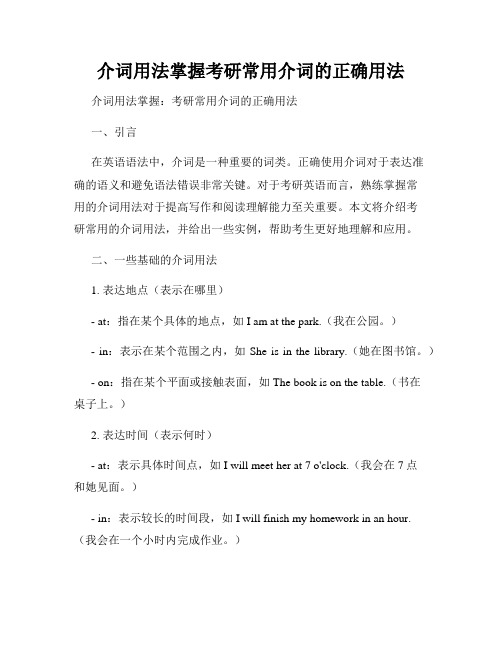
介词用法掌握考研常用介词的正确用法介词用法掌握:考研常用介词的正确用法一、引言在英语语法中,介词是一种重要的词类。
正确使用介词对于表达准确的语义和避免语法错误非常关键。
对于考研英语而言,熟练掌握常用的介词用法对于提高写作和阅读理解能力至关重要。
本文将介绍考研常用的介词用法,并给出一些实例,帮助考生更好地理解和应用。
二、一些基础的介词用法1. 表达地点(表示在哪里)- at:指在某个具体的地点,如 I am at the park.(我在公园。
)- in:表示在某个范围之内,如 She is in the library.(她在图书馆。
)- on:指在某个平面或接触表面,如 The book is on the table.(书在桌子上。
)2. 表达时间(表示何时)- at:表示具体时间点,如 I will meet her at 7 o'clock.(我会在7点和她见面。
)- in:表示较长的时间段,如 I will finish my homework in an hour.(我会在一个小时内完成作业。
)- on:表示在某个具体的日期或星期几,如 I will have a meeting on Monday.(我会在星期一开会。
)3. 表示原因和目的- for:表示目的,如 I bought a gift for my friend.(我给我的朋友买了一份礼物。
)- because of:表示原因,如 She couldn't go to the party because of her illness.(因为生病,她不能参加聚会。
)4. 表示方式- by:表示通过某种方式、手段或工具,如 I usually go to work by bus.(我通常坐公交去上班。
)5. 表示比较和对比- than:表示比较级,如 She is taller than her brother.(她比她的兄弟高。
介词用法详解

介词用法详解介词在英语中起着连接句子成分、表示位置、时间、方式等作用。
正确的使用介词对于掌握英语语法和提高英语表达能力非常重要。
本文将详细解析英语常见的介词用法。
一、在时间表示中的用法1. 表示具体时间点:at- I will meet you at 8 o'clock.- I have an appointment at noon.2. 表示时间段:in- We usually go on vacation in summer.- She finished the report in two hours.3. 表示一段时间之前或之后:before / after- I will call you before dinner.- He arrived after the meeting started.二、在地点表示中的用法1. 表示具体地点:at / in / on- She is waiting for you at the bus stop.- The library is in the city center.- The children are playing on the playground.2. 表示方向:to / towards- I walked to the park.- They ran towards the exit.三、在方式表示中的用法1. 表示方式和手段:by- We traveled to Beijing by train.- He sent the document by email.2. 表示交通工具:on / by- I go to work on foot.- She goes to school by bus.四、在原因和目的表示中的用法1. 表示原因:because of- The game was canceled because of the bad weather. - He couldn't attend the party because of his illness.2. 表示目的:for- I bought a gift for my friend's birthday.- We studied hard for the upcoming exam.五、在其他表示中的用法1. 表示关系:of- The book on the table is mine.- The color of the car is blue.2. 表示所属关系:of- The top of the mountain was covered in snow.- The tail of the dog was wagging happily.总结:介词在英语中有着不同的用法,包括时间、地点、方式、原因和目的等方面。
英语语法 介词如何表示方式

英语语法介词如何表示方式介词在英语语法中也被广泛用于表示方式,帮助我们描述某个动作或行为是以什么方式或方式进行的。
下面是介词在表示方式方面的常见用法:1. in:-用于表示以某种状态或方式进行(She spoke in a confident manner,她以自信的方式说话)。
-用于表示以某种方法或手段进行(He communicated with her in English,他用英语与她交流)。
2. by:-用于表示通过某种手段或方式进行(She solved the problem by herself,她靠自己解决了问题)。
-用于表示以某种方式或方法进行(They learned to swim by watching instructional videos,他们通过观看教学视频学会了游泳)。
3. with:-用于表示使用某种工具或手段进行(He wrote the letter with a pen,他用钢笔写信)。
-用于表示以某种方式或方式进行(She approached the situation with caution,她以谨慎的方式处理了这个情况)。
4. through:-用于表示通过某种手段或方式进行(They achieved success through hard work,他们通过努力工作取得了成功)。
-用于表示以某种方法或手段进行(He learned to play the piano through online tutorials,他通过在线教程学会了弹钢琴)。
5. by means of:-用于表示通过某种手段、方法或工具进行(They communicated with each other by means of sign language,他们通过手语彼此交流)。
6. with the help of:-用于表示在某人或某物的帮助下进行(She completed the project with the help of her team,在她团队的帮助下,她完成了这个项目)。
英语语法介词用法3篇

英语语法介词用法3篇工欲善其事,必先利其器。
愿你从容不迫,待你潇洒凯旋。
中考不退却,逆袭全世界。
今日有心苦勤奋,明朝一举步青云。
下面是小编给大家带来的英语语法介词用法,欢迎大家阅读参考,我们一起来看看吧!英语语法:介词介词介词不能单独使用,必须和名词、代词或动名词构成介词短语,在句中做表语,定语、状语、补语等成分。
根据介词的用法,通常可以分为:时间、地点、趋向和其他四类介词。
一、表示时间的介词:(1) at 示时刻、时间的某一点 at six, at noon, at half past one, at that time / momenton 体的某一天on Sunday, on Friday afternoon, on a cold morning,on the morning of … on March 12th, 2005in 示周、月、季节、年以及泛指的上、下午,晚上in spring, in 2004, in the morning,在his, last,that, next, every 等词前面不用介词this afternoon, last Sunday, every morning区别:next week -------- the next week(2) by “在……前” 多和完成时态连用till “直到……才” I’ll wait here till you come back.until “不到……就不” 常和until连用I’ll not leave until you come back.(3) in 过……以后, 大多用于将来时 after 多用于过去时(4) since + 过去的一个时间点 (表示时间段, 从……开始到现在)for + 一段时间二、表示场所、方向的介词:(1)at 表示比较具体的地点 at 37 Renming Roadin 表示比较宽敞的地点 in Renming Street(2)above斜上方-------below斜下方over正上方-------under 正下方on 两物体有接触(3) between…and..在……和……之间 among在……中间(三者以上)(4) across (从物体表面)跨越, 越过 through (从物体中间)穿透, 穿越(5)in 在……里面(表示静止的位置) into 进入,表示运动方向,常用在表示动作的动词之后, 如 go, come, walk, jump, run 等 into的反义词是out of(6)to 到 (目底地)或方向 towards 指朝着某方向,而不是目的地.He walked towards the beach.三、其它介词1.with (1)在一起; (2)有; (3)用某种工具in 用什么材料或语言,或表示衣着,声调特点等by 用......手段2.Like 象......一样as 作为;按照,象......一样(连词)+ 句子3.for(1)为了(表示目的或原因) (2)(后面加一段时间)表示时间段英语中考:介词短语[介词短语聚焦]“介词+名词/代词”所构成的短语称为介词短语。
介词的正确使用技巧
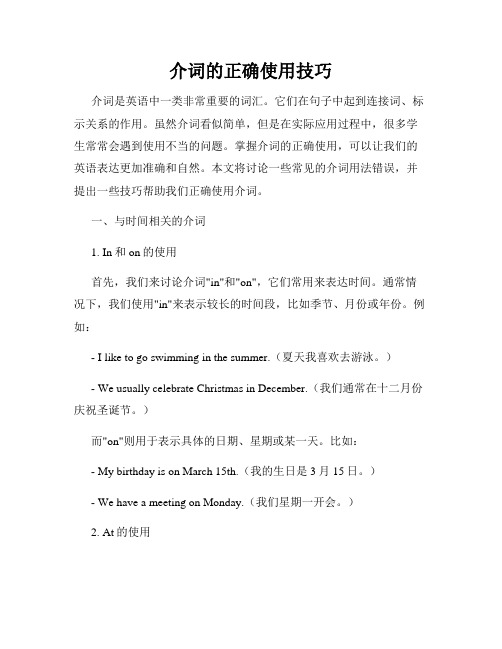
介词的正确使用技巧介词是英语中一类非常重要的词汇。
它们在句子中起到连接词、标示关系的作用。
虽然介词看似简单,但是在实际应用过程中,很多学生常常会遇到使用不当的问题。
掌握介词的正确使用,可以让我们的英语表达更加准确和自然。
本文将讨论一些常见的介词用法错误,并提出一些技巧帮助我们正确使用介词。
一、与时间相关的介词1. In和on的使用首先,我们来讨论介词"in"和"on",它们常用来表达时间。
通常情况下,我们使用"in"来表示较长的时间段,比如季节、月份或年份。
例如:- I like to go swimming in the summer.(夏天我喜欢去游泳。
)- We usually celebrate Christmas in December.(我们通常在十二月份庆祝圣诞节。
)而"on"则用于表示具体的日期、星期或某一天。
比如:- My birthday is on March 15th.(我的生日是3月15日。
)- We have a meeting on Monday.(我们星期一开会。
)2. At的使用除了"in"和"on",我们还有一个常用的表示时间的介词"at"。
"at"通常用于具体的时刻或特定时间点。
例如:- Let's meet at 2 p.m.(我们两点见。
)- The party starts at 8 o'clock.(晚上八点开始派对。
)二、与地点相关的介词1. In、on和at的使用我们经常会使用介词来描述地点。
"in"、"on"和"at"也在这方面起到了重要作用。
通常情况下,我们使用"in"来表示较大的地点范围,比如城市、国家或大洲。
英语介词的使用方法
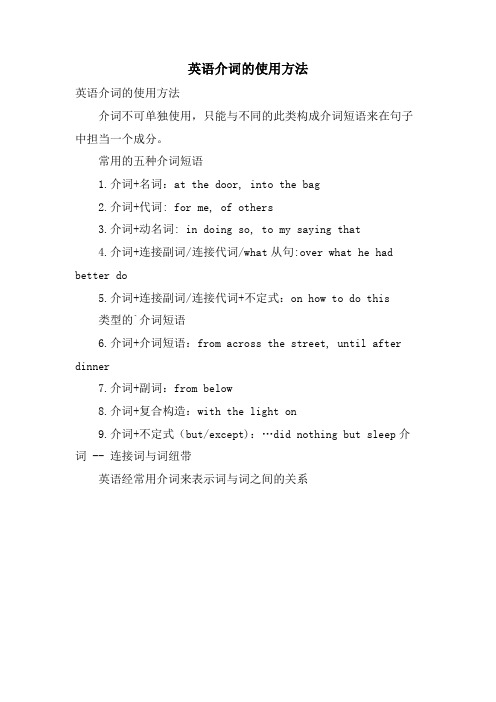
英语介词的使用方法
英语介词的使用方法
介词不可单独使用,只能与不同的此类构成介词短语来在句子中担当一个成分。
常用的五种介词短语
1.介词+名词:at the door, into the bag
2.介词+代词: for me, of others
3.介词+动名词: in doing so, to my saying that
4.介词+连接副词/连接代词/what从句:over what he had better do
5.介词+连接副词/连接代词+不定式:on how to do this
类型的`介词短语
6.介词+介词短语:from across the street, until after dinner
7.介词+副词:from below
8.介词+复合构造:with the light on
9.介词+不定式(but/except):…did nothing but sleep介词 -- 连接词与词纽带
英语经常用介词来表示词与词之间的关系。
介词的用法总结
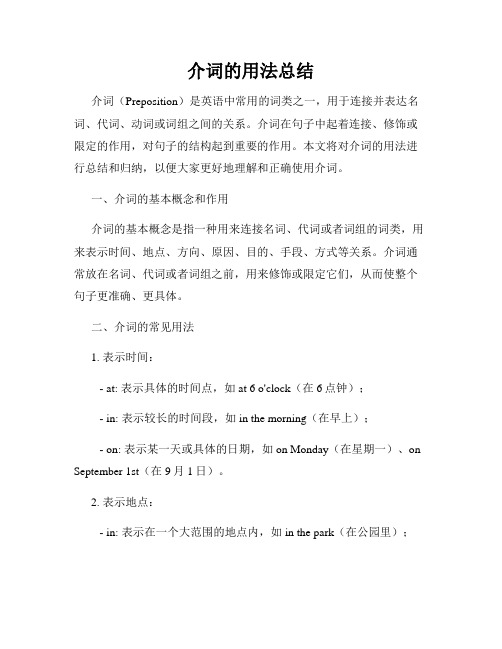
介词的用法总结介词(Preposition)是英语中常用的词类之一,用于连接并表达名词、代词、动词或词组之间的关系。
介词在句子中起着连接、修饰或限定的作用,对句子的结构起到重要的作用。
本文将对介词的用法进行总结和归纳,以便大家更好地理解和正确使用介词。
一、介词的基本概念和作用介词的基本概念是指一种用来连接名词、代词或者词组的词类,用来表示时间、地点、方向、原因、目的、手段、方式等关系。
介词通常放在名词、代词或者词组之前,用来修饰或限定它们,从而使整个句子更准确、更具体。
二、介词的常见用法1. 表示时间:- at: 表示具体的时间点,如at 6 o'clock(在6点钟);- in: 表示较长的时间段,如in the morning(在早上);- on: 表示某一天或具体的日期,如on Monday(在星期一)、on September 1st(在9月1日)。
2. 表示地点:- in: 表示在一个大范围的地点内,如in the park(在公园里);- at: 表示在一个小范围或精确的地点,如at the cinema(在电影院);- on: 表示在某个平面上或者与表面接触,如on the table(在桌子上)。
3. 表示方向:- to: 表示朝向某个地点或目的地,如go to school(去学校);- from: 表示起始地点,如come from China(来自中国);- towards: 表示朝向某个方向,如walk towards the park(走向公园)。
4. 表示原因:- because of: 表示由于某个原因,如because of the rain(因为下雨);- due to: 表示由于某个原因,如due to the bad weather(由于天气恶劣)。
5. 表示目的:- for: 表示为了某个目的,如study for the exam(为了考试而学习);- to: 表示某个行动的目的,如go to the park(去公园)。
英语介词的正确使用方法

英语介词的正确使用方法
在英语中,介词是用来连接名词、代词、动词或短语的词语。
介词通常用来表示时间、地点、原因、目的、方式等关系。
以下是一些常用的介词及其正确使用方法:
1.在时间方面的使用:
- at:用于具体的时刻或时间点,如at 6 o'clock(在六点钟)、at Christmas(在圣诞节)。
- in:用于较长的时间段,如in the morning(在早上)、in May (在五月)。
- on:用于其中一天、日期或特定的时间,如on Sunday(在星期天)、on July 10th(在7月10日)。
2.在地点方面的使用:
- at:用于具体的点、位置,如at the bus stop(在公交车站)。
- in:用于大的地点范围,如in the city(在城市)。
- on:用于平面上的位置或方位,如on the table(在桌子上)。
3.在原因和目的方面的使用:
- for:表示为了目的,如I study for my exams(我为了考试而学习)。
4.在方式和手段方面的使用:
- by:表示通过其中一种方式或手段,如by car(乘坐汽车)、by email(通过电子邮件)。
- with:表示使用物或与人一起做事,如write with a pen(用钢笔写)、go with a friend(和朋友一起去)。
此外,有些介词在特定短语中使用时有固定的搭配,需根据具体语境学习和掌握。
最好的方法是在阅读和听力中积累和理解介词的正确用法,并在实际语言交流中多加练习和应用。
英语介词用法最全总结
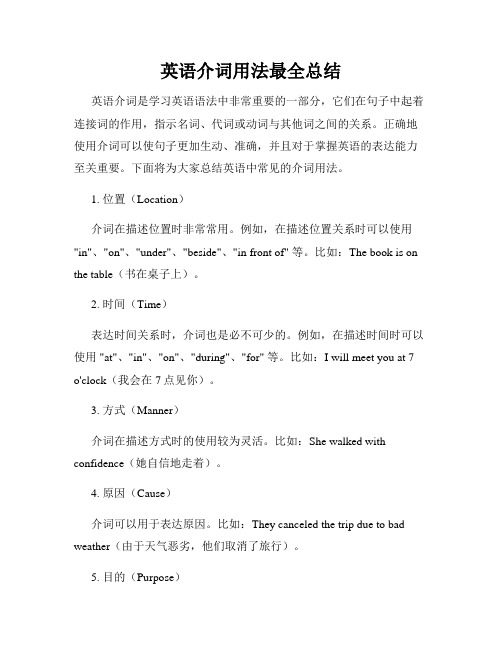
英语介词用法最全总结英语介词是学习英语语法中非常重要的一部分,它们在句子中起着连接词的作用,指示名词、代词或动词与其他词之间的关系。
正确地使用介词可以使句子更加生动、准确,并且对于掌握英语的表达能力至关重要。
下面将为大家总结英语中常见的介词用法。
1. 位置(Location)介词在描述位置时非常常用。
例如,在描述位置关系时可以使用"in"、"on"、"under"、"beside"、"in front of" 等。
比如:The book is on the table(书在桌子上)。
2. 时间(Time)表达时间关系时,介词也是必不可少的。
例如,在描述时间时可以使用 "at"、"in"、"on"、"during"、"for" 等。
比如:I will meet you at 7 o'clock(我会在7点见你)。
3. 方式(Manner)介词在描述方式时的使用较为灵活。
比如:She walked with confidence(她自信地走着)。
4. 原因(Cause)介词可以用于表达原因。
比如:They canceled the trip due to bad weather(由于天气恶劣,他们取消了旅行)。
5. 目的(Purpose)介词也能表达目的。
比如:He went to the store to buy some groceries (他去商店买些食品)。
6. 所属关系(Possession)介词可以用于表达所属关系。
比如:This book belongs to me(这本书是我的)。
7. 比较(Comparison)在进行比较时,介词也可以派上用场。
比如:I am taller than my sister(我比我妹妹高)。
介词的用法与搭配
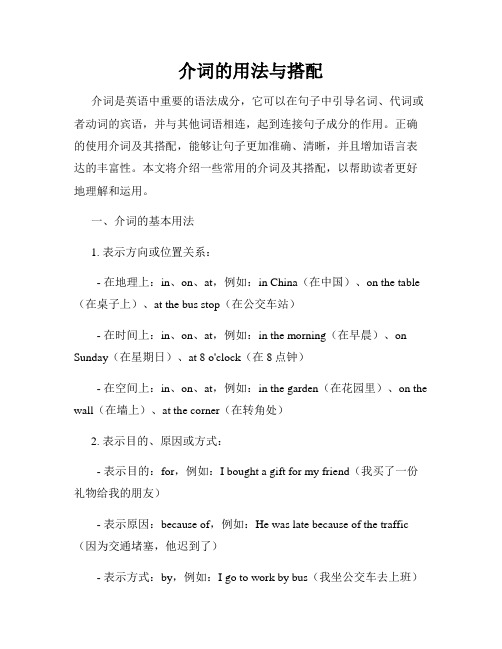
介词的用法与搭配介词是英语中重要的语法成分,它可以在句子中引导名词、代词或者动词的宾语,并与其他词语相连,起到连接句子成分的作用。
正确的使用介词及其搭配,能够让句子更加准确、清晰,并且增加语言表达的丰富性。
本文将介绍一些常用的介词及其搭配,以帮助读者更好地理解和运用。
一、介词的基本用法1. 表示方向或位置关系:- 在地理上:in、on、at,例如:in China(在中国)、on the table (在桌子上)、at the bus stop(在公交车站)- 在时间上:in、on、at,例如:in the morning(在早晨)、on Sunday(在星期日)、at 8 o'clock(在8点钟)- 在空间上:in、on、at,例如:in the garden(在花园里)、on the wall(在墙上)、at the corner(在转角处)2. 表示目的、原因或方式:- 表示目的:for,例如:I bought a gift for my friend(我买了一份礼物给我的朋友)- 表示原因:because of,例如:He was late because of the traffic (因为交通堵塞,他迟到了)- 表示方式:by,例如:I go to work by bus(我坐公交车去上班)3. 表示从属关系或比较:- 表示从属:of,例如:the book of Tom(汤姆的书)- 表示比较:than,例如:He is taller than me(他比我高)二、介词的搭配用法1. in的搭配用法:- in front of(在...前面),例如:He is standing in front of the building(他站在建筑物前面)- in the middle of(在...中间),例如:She is sitting in the middle of the room(她正坐在房间中间)- in addition to(除了...之外),例如:In addition to English, she also speaks French(除了英语,她还会讲法语)2. on的搭配用法:- on the left/right(在左/右边),例如:The bank is on the left side of the street(银行在街道的左边)- on top of(在...顶部),例如:There is a cup on top of the table (桌子上有一个杯子)- on behalf of(代表),例如:She is speaking on behalf of the team (她在代表团队发言)3. at的搭配用法:- at the beginning/end of(在...的开始/结束处),例如:At the endof the movie, everyone applauded(电影结束时,大家鼓掌) - at the same time(同时),例如:They arrived at the same time(他们同时到达)- at the age of(在...岁时),例如:He achieved his first success atthe age of 25(他25岁时取得了第一次成功)三、练习与总结正确使用介词需要不断练习,以下是一些练习题供读者巩固所学知识:1. 填入恰当的介词:a) He lives _______ the third floor.b) She is interested _______ learning foreign languages.c) We will meet _______ the library.2. 将下列句子翻译成英语:a) 我在上课的时候坐在教室后面。
语法中的介词短语的位置要求和注意事项详解
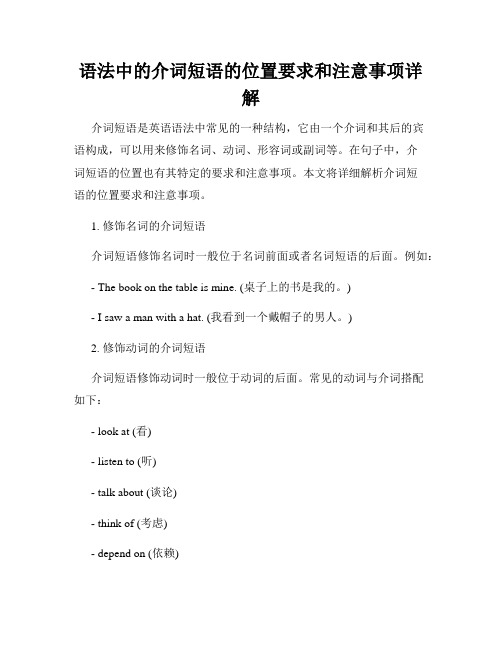
语法中的介词短语的位置要求和注意事项详解介词短语是英语语法中常见的一种结构,它由一个介词和其后的宾语构成,可以用来修饰名词、动词、形容词或副词等。
在句子中,介词短语的位置也有其特定的要求和注意事项。
本文将详细解析介词短语的位置要求和注意事项。
1. 修饰名词的介词短语介词短语修饰名词时一般位于名词前面或者名词短语的后面。
例如:- The book on the table is mine. (桌子上的书是我的。
)- I saw a man with a hat. (我看到一个戴帽子的男人。
)2. 修饰动词的介词短语介词短语修饰动词时一般位于动词的后面。
常见的动词与介词搭配如下:- look at (看)- listen to (听)- talk about (谈论)- think of (考虑)- depend on (依赖)- wait for (等待)例如:- She is looking at the picture. (她正在看图片。
)- We talked about our plans. (我们谈论了我们的计划。
)3. 修饰形容词的介词短语介词短语修饰形容词时一般位于形容词的后面。
例如:- I am proud of you. (我为你感到骄傲。
)- He is famous for his paintings. (他以他的绘画而闻名。
)4. 修饰副词的介词短语介词短语修饰副词时一般位于副词的后面。
例如:- She ran across the field quickly. (她快速地跑过田野。
)- He spoke in a loud voice. (他用大声说话的声音说话。
)除了以上的位置要求之外,在使用介词短语时还需要注意以下几点:1. 词序的正确性介词短语中的词序要符合英语语法的要求,一般是介词+宾语。
例如:- He is interested in art. (他对艺术感兴趣。
英语句子中介词的使用技巧
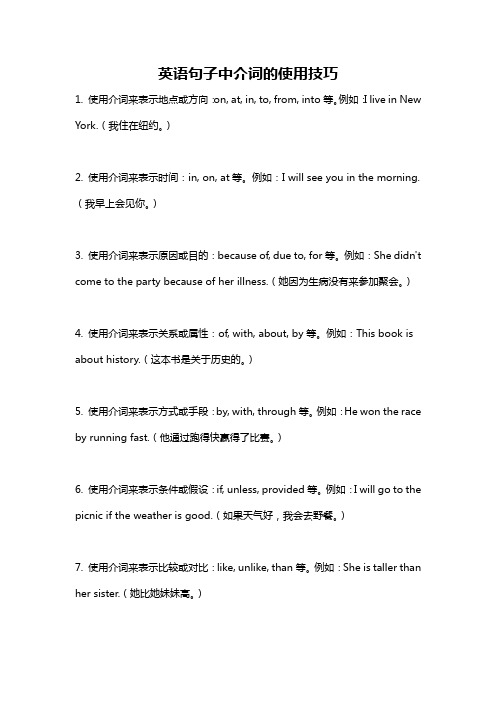
英语句子中介词的使用技巧1. 使用介词来表示地点或方向:on, at, in, to, from, into等。
例如:I live in New York.(我住在纽约。
)2. 使用介词来表示时间:in, on, at等。
例如:I will see you in the morning.(我早上会见你。
)3. 使用介词来表示原因或目的:because of, due to, for等。
例如:She didn't come to the party because of her illness.(她因为生病没有来参加聚会。
)4. 使用介词来表示关系或属性:of, with, about, by等。
例如:This book is about history.(这本书是关于历史的。
)5. 使用介词来表示方式或手段:by, with, through等。
例如:He won the race by running fast.(他通过跑得快赢得了比赛。
)6. 使用介词来表示条件或假设:if, unless, provided等。
例如:I will go to the picnic if the weather is good.(如果天气好,我会去野餐。
)7. 使用介词来表示比较或对比:like, unlike, than等。
例如:She is taller than her sister.(她比她妹妹高。
)8. 使用介词来表示目标或目的地:to, towards, for等。
例如:I am going to the supermarket to buy some groceries.(我要去超市买些食品杂货。
)9. 使用介词来表示习惯或常态:always, usually, often等。
例如:She always goes to bed at 10 o'clock.(她通常在10点上床睡觉。
英语介词的用法与搭配
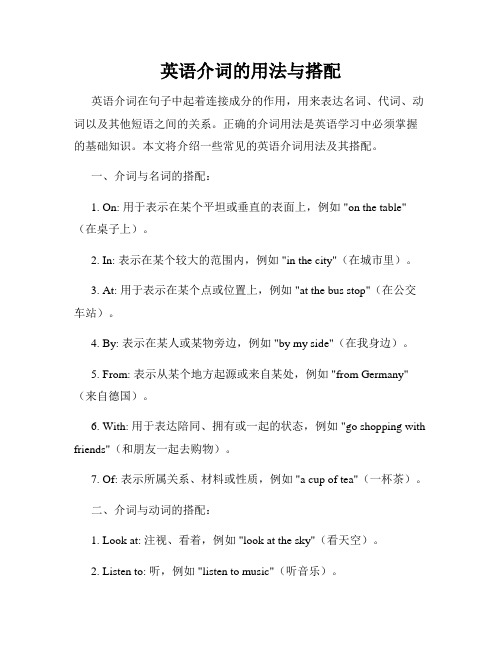
英语介词的用法与搭配英语介词在句子中起着连接成分的作用,用来表达名词、代词、动词以及其他短语之间的关系。
正确的介词用法是英语学习中必须掌握的基础知识。
本文将介绍一些常见的英语介词用法及其搭配。
一、介词与名词的搭配:1. On: 用于表示在某个平坦或垂直的表面上,例如 "on the table"(在桌子上)。
2. In: 表示在某个较大的范围内,例如 "in the city"(在城市里)。
3. At: 用于表示在某个点或位置上,例如 "at the bus stop"(在公交车站)。
4. By: 表示在某人或某物旁边,例如 "by my side"(在我身边)。
5. From: 表示从某个地方起源或来自某处,例如 "from Germany"(来自德国)。
6. With: 用于表达陪同、拥有或一起的状态,例如 "go shopping with friends"(和朋友一起去购物)。
7. Of: 表示所属关系、材料或性质,例如 "a cup of tea"(一杯茶)。
二、介词与动词的搭配:1. Look at: 注视、看着,例如 "look at the sky"(看天空)。
2. Listen to: 听,例如 "listen to music"(听音乐)。
3. Talk to: 和某人交谈,例如 "talk to your teacher"(和你的老师交谈)。
4. Think of: 考虑,例如"think of a solution"(考虑一个解决方案)。
5. Wait for: 等待,例如 "wait for the bus"(等待公交车)。
6. Depend on: 依赖、依靠,例如 "depend on your parents"(依靠你的父母)。
- 1、下载文档前请自行甄别文档内容的完整性,平台不提供额外的编辑、内容补充、找答案等附加服务。
- 2、"仅部分预览"的文档,不可在线预览部分如存在完整性等问题,可反馈申请退款(可完整预览的文档不适用该条件!)。
- 3、如文档侵犯您的权益,请联系客服反馈,我们会尽快为您处理(人工客服工作时间:9:00-18:30)。
(二)考查表示地点的介词 in/ on / at at—与小的地点连用, 有“在某一点”的 含义。
at the station/ airport / at the cinema/
arrive at a village in—与大的地方连用或表示在一个立体 空间内”的含义。
eg. I will go(A) to the cinema(B) iபைடு நூலகம்(C) this
evening.
____B__去__掉_i_n____
注意:at night= in the night
at noon
at this / that time
at Christmas 区别 on Christmas Day
on a cold morning/on a sunny afternoon
on a hot summer night
另外注意:在时间词(morning , afternoon , evening ; Sunday…)前有last, next , this , that时,不再用介词. tomorrow, tonight前 也不用介词。
The answer to the question for– 表示用途
The tickets for the game
(十一) Except / besides/except for except – 表示除了,不包括在内 besides---- 除了包括,还有。 except for—除去的内容和主语不是同一类。
除星期天之外,我天天上学。
4. Nobody came_e_x_ce_p_t_____ me.
除了我之外没人来
5. Your picture is good _ex_c_e_p_t _fosrome of the colours.
你的画很好,除了有些颜色不好
6. Smith is a good man, _ex_c_e_p_t_fo_r_ his bad temper.
(一)考查表示时间的介词in, on, at, after
in——用于较长一段时间, 星期, 月份, 季节, 年, 朝代 世纪或非特指的早、午、晚等。
eg: in 1988, in the 21st century, in winter, in March, in the day, in the morning,
(三) in/ to/ on表示方位 in– 表示一个地方在另一个地方的范围内 to– 表示两地相隔 on--- 表示两地相邻 Shenzhen is in the southeast of Guangdong. Changsha is to the north of Guangzhong. Henggang is on the east of Longgang.
in
on
to
(四) across/ through, cross 表示”越过、穿过” cross: 动词“跨过,越过”=go(动词) across across: (表面)跨过 through: (内部)穿过,贯穿 介词 eg. 1)Can you swim __a_c_c_r_o_s_s__ the river?
史密斯除了脾气不好外,是个好人。
7. The movie was good ___e_x_ce_p_t_f_o_r___ the ending.
这部电影除了结尾之外都很好。
(十二)with 的一些用法 1)在..下 with her help 2) 随着 with the development of China. (十三)towards与to的区别 以wards结尾的词表示方向的还有:forwards朝前;
(七)by/ in/ with 表示通过是使用某物 in --- in+ 材料/语言/ in ink / in English with--- with + 具体工具 with a pen by ---- by+ 名词表方式 by hand/by phone
1) Please write the letter __w__it_h___ a pencil. 2) Please speak ____in____ a loud voice.
eg. 1._in__ the morning 2._o_n_ Monday morning
3. _o_n_ a rainy evening
4. _a_t_3:50
5._in_ 2002
6._o_n_ the morning of April 10 7.__in_ spring
8._a_t_ night 9._a_t_ this time 10. __in_ March
in the room/ arrive in a big city on– 表示沿途/ 沿着边
on the side of the road/ on the right/ left
on the bank of the river
eg. 1)He arrived _in__Shanghai yesterday. 2)They arrived _a_t_a small village before dark. 3)There is a big hole _i_n__ the wall. 4)The teacher put up a picture __o_n_ the wall.
(一)考查表示时间的介词for,since,during
for + 一段时间常表示“持续了一段时间”, since + 时间点/ + 完成时 during则表示在……期间+ 一般时态 He has been in Beijing for 3 years. He has been in Beijing since 3 three years ago I was in Beijing during last summer.
【拓展考点1】
in+一段时间,表示一段时间之后,与动词将来时 连用。
after则常用于过去时。 比较:He will be back in two days.
He came back after two days. 易错题:
--_______ will the film start?
--In ten minutes.
2)The road runs __th_r_o_u_g_h___ the forest. 3) ___C_r_o_s_s___ the bridge, you’ll find a cinema.
(五) between: 在(两者)之间 among :在(三者以上)之间
1)A big crowd of people were waiting for Li Lida on the beach. _A__m_o_n__g_ them were his parents.
1. I can speak Japanese,b_es_i_d_esEnglish and Chinese.
除了英语和中文,我还会说日语。
2. What did you want __b_e_s_id_e_s__ these?
除了这些东西外,你还要什么?(包括these)
3. I go to school every daye_x_c_e_pt______ Sunday .
The bridge is over the river.
The cup is on the table.
(十) of/ to/ for表示事物之间的关系 of --- 所属关系。 如:The door of the room
The friend of my father’s to --- 两物之间的联系 The key to the exercise 这个练习的答案 The key to the door 门的钥匙
2)Tom sits ____b__et_w__ee_n_____Lucy and Lily. 注意:课间休息 ____b_r_ea_k__t_im__e_b_e_t_w_e_e_n__c_la_s_ses
(六) with /in 表示穿衣。 in+ 颜色表示穿衣/带帽 With + 具体衣服/眼镜等 The girl in green looks very beautiful. The girl with green skirt looks very beautiful. The lady with glasses is Lucy’s mother. The boy in the hat is my neighbour.
A. How long
B. How often
C. How soon
D. How far
【拓展考点2】 On+具体某一天/节日 易错题:--When were you born? --I was born ____ the morning of May 7th, 1995.
A. in B. at C. on D. by 常见的搭配还有
(八)表示方式 by/ on in by + n. ( 运输工具) 如:by car/ship/ plane in/ on/ + the/ a /an+ 交通工具 如:in a car / on a plane
(九) over, above与on表示“在……上”的区别。 over——指没有接触面的正上方, 反义词是under。 above——指没有接触面的上方, 在高一些的位置, 反义词是below。 on——指有接触面的, 在……的表面上。 The plane is above the clouds.
backwards朝后;upwards朝上;downwards朝 下
